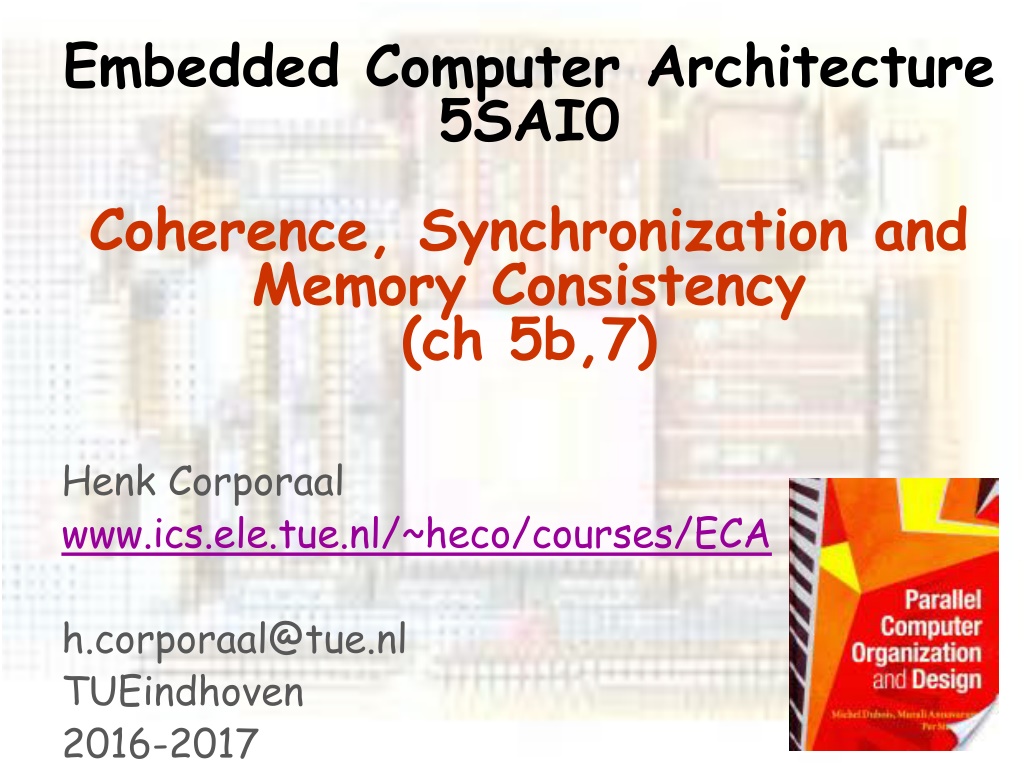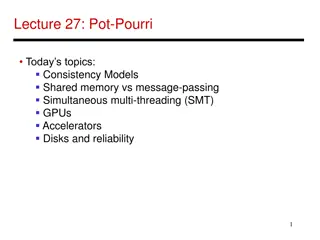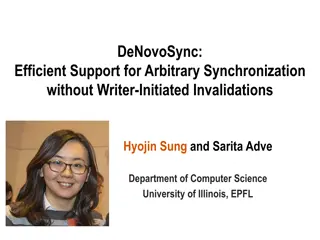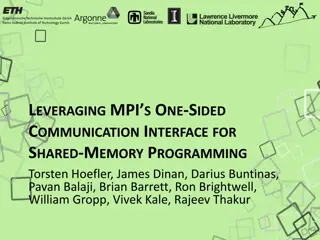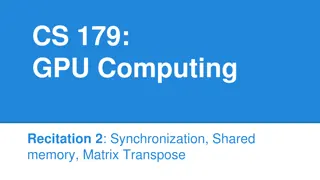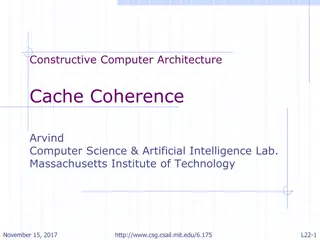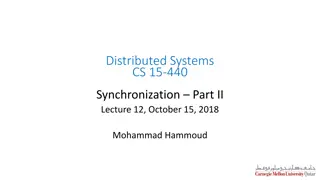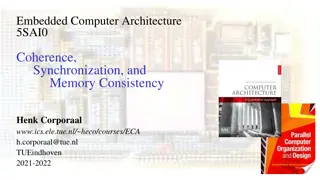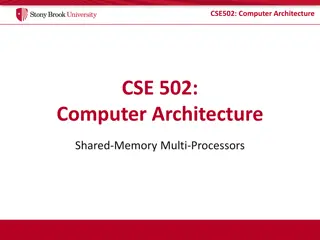Understanding Shared Memory Coherence, Synchronization, and Consistency in Embedded Computer Architecture
This content delves into the complexities of shared memory architecture in embedded computer systems, addressing key issues such as coherence, synchronization, and memory consistency. It explains how cache coherence ensures the most recent data is accessed by all processors, and discusses methods like snooping and directory-based schemes to enforce coherence. The material emphasizes the importance of maintaining consistency in read and write operations across multiple processors to prevent data discrepancies.
Download Presentation

Please find below an Image/Link to download the presentation.
The content on the website is provided AS IS for your information and personal use only. It may not be sold, licensed, or shared on other websites without obtaining consent from the author. Download presentation by click this link. If you encounter any issues during the download, it is possible that the publisher has removed the file from their server.
E N D
Presentation Transcript
Embedded Computer Architecture 5SAI0 Coherence, Synchronization and Memory Consistency (ch 5b,7) Henk Corporaal www.ics.ele.tue.nl/~heco/courses/ECA h.corporaal@tue.nl TUEindhoven 2016-2017 Embedded Computer Architecture 1
Welcome back Shared memory architecture issues Coherence Synchronization Consistency Material from book: Chapter 5.4 5.4.3 Chapter 7.4-7.6 Embedded Computer Architecture 2
Three fundamental issues for shared memory multiprocessors Coherence, about: Do I see the most recent data? Consistency, about: When do I see a written value? e.g. do different processors see writes at the same time (w.r.t. other memory accesses)? Synchronization How to synchronize processes? how to protect access to shared data? Embedded Computer Architecture 3
Cache Coherence Example Problem Processors may see different values through their caches: Embedded Computer Architecture 4
Cache Coherence Coherence All reads by any processor must return the most recently written value Writes to the same location by any two processors are seen in the same order by all processors Consistency It s about the observed order of all reads and writes by the different processors is this order for every processor the same? At least should be valid: If a processor writes location A followed by location B, any processor that sees the new value of B must also see the new value of A Embedded Computer Architecture 5
Enforcing Coherence Coherent caches provide: Migration: movement of data Replication: multiple copies of data Cache coherence protocols Snooping Each core tracks sharing status of each block Directory based Sharing status of each block kept in one location Embedded Computer Architecture 6
Potential HW Coherency Solutions Snooping Solution (Snoopy Bus): Send all requests for data to all processors (or local caches) Processors snoop to see if they have a copy and respond accordingly Requires broadcast, since caching information is at processors Works well with bus (natural broadcast medium) Dominates for small scale machines (most of the market) Directory-Based Schemes Keep track of what is being shared in one centralized place Distributed memory => distributed directory for scalability (avoids bottlenecks, hot spots) Scales better than Snooping Actually existed BEFORE Snooping-based schemes 10/4/2024 ACA H.Corporaal 7
Snoopy Coherence Protocols Core i7 has 3-levels of caching level 3 is shared between all cores levels 1 and 2 have to be kept coherent by e.g. snooping. Locating an item when a read miss occurs In write-through cache: item is always in (shared) memory note for a core i7 this can be L3 cache In write-back cache, the updated value must be sent to the requesting processor Cache lines marked as shared or exclusive/modified Only writes to shared lines need an invalidate broadcast After this, the line is marked as exclusive Embedded Computer Architecture 8
Example Snooping protocol 3 states for each cache line: invalid, shared (read only), modified (also called exclusive, you may write it) FSM per cache, gets requests from processor and bus Processor Processor Processor Processor Cache Cache Cache Cache Main memory I/O System 10/4/2024 ACA H.Corporaal 9
Snooping Protocol: Write Invalidate Get exclusive access to a cache block (invalidate all other copies) before writing it When processor reads an invalid cache block it is forced to fetch a new copy If two processors attempt to write simultaneously, one of them is first (bus arbitration). The other one must obtain a new copy, thereby enforcing serialization Example: address X in memory initially contains value '0' Processor activity Bus activity Cache CPU A Cache CPU B Memory addr. X 0 CPU A reads X Cache miss for X 0 0 CPU B reads X Cache miss for X 0 0 0 CPU A writes 1 to X Invalidation for X 1 0 invalidated CPU B reads X Cache miss for X 1 1 1 10/4/2024 ACA H.Corporaal 10
Basics of Write Invalidate Use the bus to perform invalidates To perform an invalidate, acquire bus access and broadcast the address to be invalidated all processors snoop the bus, listening to addresses if the address is in my cache, invalidate my copy Serialization of bus access enforces write serialization Where is the most recent value? Easy for write-through caches: in the memory For write-back caches, again use snooping Can use cache tags to implement snooping Might interfere with cache accesses coming from CPU Duplicate tags, or employ multilevel cache with inclusion corei Processor Cache Bus Memory 10/4/2024 ACA H.Corporaal 11
Snoopy-Cache State Machine-I CPU Read hit State machine for CPU requests for each cache block CPU Read Shared (read-only) Invalid Place read miss on bus CPU Write CPU Read miss Place read miss on bus CPU read miss Write back block Place Write Miss on bus CPU Write Place Write Miss on Bus Cache Block State Exclusive (read/write) CPU read hit CPU write hit CPU Write Miss Write back cache block Place write miss on bus 10/4/2024 ACA H.Corporaal 12
Snoopy-Cache State Machine-II State machine for bus requests for each cache block Write miss for this block Shared (read/only) Invalid Write Back Block; (abort memory access) Write Back Block; (abort memory access) Write miss for this block Read miss for this block Exclusive (read/write) 10/4/2024 ACA H.Corporaal 13
Responds to Events Caused by Processor State of block in cache Action shared or exclusive invalid shared Event Read hit Read miss Read miss read data from cache place read miss on bus wrong block (conflict miss): place read miss on bus Read miss exclusive conflict miss: write back block then place read miss on bus write data in cache place write miss on bus (invalidates all other copies) place write miss on bus conflict miss: place write miss on bus conflict miss: write back block, then place write miss on bus Write hit Write hit exclusive shared Write miss Write miss invalid shared Write miss exclusive 10/4/2024 ACA H.Corporaal 14
Responds to Events on Bus State of addressed cache block shared Event Action Read miss No action: memory services read miss Attempt to share data: place block on bus and change state to shared Attempt to write: invalidate block Another processor attempts to write "my" block: write back the block and invalidate it Read miss exclusive Write miss shared Write miss exclusive 10/4/2024 ACA H.Corporaal 15
Snoopy Coherence Protocols Complications for the basic MSI (Modified, Shared, Invalid) protocol: Operations are not atomic E.g. detect miss, acquire bus, receive a response Creates possibility of deadlock and races One solution: processor that sends invalidate can hold bus until other processors receive the invalidate Extensions: Add exclusive state (E) to indicate clean block in only one cache (MESI protocol) Prevents needing to write invalidate on a write Owned state (O), used by AMD (MOESI protocol) A block can change from M -> O when others will share it, but the block is not written back to memory. It is shared by 2 or more processors, but owned by 1. This one is responsible for writing it back (to next level), when needed. Embedded Computer Architecture 16
Coherence Protocols: Extensions Shared memory bus and snooping bandwidth is bottleneck for scaling symmetric multiprocessors Duplicating tags Place directory in outermost cache Use crossbars or point- to-point networks with banked memory Embedded Computer Architecture 17
Performance Coherence influences cache miss rate Coherence misses True sharing misses Write to shared block (transmission of invalidation) Read an invalidated block False sharing misses Read an unmodified word in an invalidated block Cache block: (4 words) written by P1 written by P2 Embedded Computer Architecture 18
Performance Study: Commercial Workload Strange effect with increasing L3: fewer memory accesses but larger idle time Embedded Computer Architecture 19
Performance Study: Commercial Workload influence of L3 cache size What do you observe here? Embedded Computer Architecture 20
Performance Study: Commercial Workload influence of L3 cache size More true sharing with increasing number of processors Embedded Computer Architecture 21
Performance Study: Commercial Workload Larger blocks are effective, but false sharing increases Embedded Computer Architecture 22
Directory Protocols (5.5.1-5.5.2) Directory keeps track of every block Which caches have each block Dirty status of each block Implement in shared L3 cache Keep bit vector of size = # cores for each block in L3 Directory implemented in a distributed fashion: Embedded Computer Architecture 23
Scalable cache coherence solutions Bus-based multiprocessors are inherently non-scalable Scalable cache protocols should keep track of sharers Embedded Computer Architecture 24
Directory-based protocols Embedded Computer Architecture 25
Presence-flag vector scheme Example: Block 1 is cached by proc. 2 only and is dirty Block N is cached by all processors and is clean Let s consider how the protocol works Embedded Computer Architecture 26
cc-NUMA protocols Use same protocol as for snooping protocols (e.g. MSI-invalidate, MSI-update or MESI, etc.) Protocol agents: Home node (h): node where the memory block and its directory entry reside Requester node (r): node making the request Dirty node (d): node holding the latest, modified copy Shared nodes (s): nodes holding a shared copy Home may be the same node as requester or dirty Note: busy bit per entry Home Dirty Requester Embedded Computer Architecture 27
MSI invalidate protocol in cc-NUMAs Note: in MSI-update the transitions are the same except that updates are sent instead of invalidations Embedded Computer Architecture 28
Reducing latencies in directory protocols Baseline dir. protocol invokes four hops (in worst case) on a remote miss. Optimizations are possible 1. Request is sent to home 2. Home redirects the request to remote 3. Remote responds to local 4. Local notifies home (off the critical access path) Embedded Computer Architecture 29
Memory requirements of directory protocols Memory requirement of a presence-flag vector protocol n processors (nodes) m memory blocks per node b block size Size of directory = m x n2 Directory scales with the square of number of processors; a scalability concern! Alternatives Limited pointer protocols: maintain ipointers (each log n bits) instead of n as in presence flag vectors Memory overhead = size (dir) / (size(memory) + size(dir)) Example memory overhead for limited pointer scheme: m x n x i log n / (m x n x b + m x n x i log n) = i log n / (b + i log n) Embedded Computer Architecture 30
Other scalable protocols Coarse vector scheme Presence flags identify groups rather than individual nodes Directory cache Directory overhead is proportional to dir. Cache size instead of main memory size (leveraging locality) Cache-centric schemes. Make overhead proportional to (private) cache size instead of memory Example: Scalable Coherent Interface (SCI) Embedded Computer Architecture 31
Hierarchical systems Instead of scaling in a flat config. we can form clusters in a hierarchical organization Relevant inside as well as across chip-multiprocessors Coherence options: Intra-cluster coherence: snoopy/directory Inter-cluster coherence: snoopy/directory Tradeoffs affect memory overhead and performance to maintain coherence Embedded Computer Architecture 32
Three fundamental issues for shared memory multiprocessors Coherence, about: Do I see the most recent data? Synchronization How to synchronize processes? how to protect access to shared data? Consistency, about: When do I see a written value? e.g. do different processors see writes at the same time (w.r.t. other memory accesses)? Embedded Computer Architecture 33
What's the Synchronization problem? Assume: Computer system of bank has credit process (P_c) and debit process (P_d) /* Process P_c */ /* Process P_d */ shared int balance private int amount shared int balance private int amount balance += amount balance -= amount lw $t0,balance lw $t2,balance lw $t1,amount lw $t3,amount add $t0,$t0,t1 sub $t2,$t2,$t3 sw $t0,balance sw $t2,balance Embedded Computer Architecture 34
Critical Section Problem n processes all competing to use some shared data; they need synchronization Each process has code segment, called critical section, in which shared data is accessed. Problem ensure that when one process is executing in its critical section, no other process is allowed to execute in its critical section Structure of process while (TRUE){ entry_section (); critical_section (); exit_section (); remainder_section (); } Embedded Computer Architecture 35
Synchronization Problem: synchronization protocol requires atomic read- write action on the bus e.g. to check a bit and if zero, set it. Basic building blocks: Atomic exchange Swaps register with memory location Test-and-set Sets under condition Fetch-and-increment Reads original value from memory and increments it in memory Requires memory read and write in uninterruptable instruction load linked/store conditional If the contents of the memory location specified by the load linked are changed before the store conditional to the same address, the store conditional fails Embedded Computer Architecture 36
Implementing Locks Spin lock If no coherence: lockit: ADDUI EXCH BNEZ R2,R0,#1 R2,0(R1) R2,lockit ;R2=1 ;atomic exchange ;already locked? If coherence, avoid too much snooping traffic: lockit: LD BNEZ ADDUI EXCH BNEZ R2,0(R1) R2,lockit R2,R0,#1 R2,0(R1) R2,lockit ;load of lock ;not available-spin ;R2=1 ;swap ;branch if lock wasn t 0 Embedded Computer Architecture 37
reduces memory traffic Embedded Computer Architecture 38
Three fundamental issues for shared memory multiprocessors Coherence, about: Do I see the most recent data? Synchronization How to synchronize processes? how to protect access to shared data? Consistency, about: When do I see a written value? e.g. do different processors see writes at the same time (w.r.t. other memory accesses)? Embedded Computer Architecture 39
Memory Consistency: The Problem Process P1 Process P2 A = 0; B = 0; ... A = 1; L1: if (B==0) ... ... B = 1; L2: if (A==0) ... Observation: If writes take effect immediately (are immediately seen by all processors), it is impossible that both if-statements evaluate to true But what if write invalidate is delayed . Should this be allowed, and if so, under what conditions? Embedded Computer Architecture 40
How to implement Sequential Consistency Delay the completion of any memory access until all invalidations caused by that access are completed Delay next memory access until previous one is completed delay the read of A and B (A==0 or B==0 in the example) until the write has finished (A=1 or B=1) Note: Under sequential consistency, we cannot place the (local) write in a write buffer and continue Embedded Computer Architecture 41
Write buffer Embedded Computer Architecture 42
Sequential Consistency overkill? Schemes for faster execution then sequential consistency Observation: Most programs are synchronized A program is synchronized if all accesses to shared data are ordered by synchronization operations Example: P1 write (x) ... release (s) {unlock} ... P2 acquire (s) {lock} ... read(x) Embedded Computer Architecture 43
Cost of Sequential Consistency (SC) Enforcing SC can be quite expensive Assume write miss = 40 cycles to get ownership, 10 cycles = to issue an invalidate and 50 cycles = to complete and get acknowledgement Assume 4 processors share a cache block, how long does a write miss take for the writing processor if the processor is sequentially consistent? Waiting for invalidates : each write =sum of ownership time + time to complete invalidates 10+10+10+10= 40 cycles to issue invalidate 40 cycles to get ownership + 50 cycles to complete =130 cycles very long ! Solutions: Exploit latency-hiding techniques Employ relaxed consistency Embedded Computer Architecture 44
Relaxed Memory Consistency Models Key: (partially) allow reads and writes to complete out-of-order Orderings that can be relaxed: relax W R ordering allows reads to bypass earlier writes (to different memory locations) called processor consistency or total store ordering relax W W allow writes to bypass earlier writes called partial store order relax R W and R R weak ordering, release consistency, Alpha, PowerPC Note, seq. consistency means: W R, W W, R W and R R Embedded Computer Architecture 45
Relaxed Consistency Models Consistency model is multiprocessor specific Programmers will often implement explicit synchronization Speculation gives much of the performance advantage of relaxed models with sequential consistency Basic idea: if an invalidation arrives for a result that has not been committed, use speculation recovery Embedded Computer Architecture 46
Shared memory is conceptually easy but requires solutions for the following 3 issues: Coherence problem caused if copies of data in system (caches) even in single processor system with DMA the problem exists Synchronization requires atomic read/write access operations to memory, like exchange, test-and-set, ... Consistency sequential the most costly, but easiest reasoning makes write buffer largely useless relaxed models used in practice Embedded Computer Architecture 47
